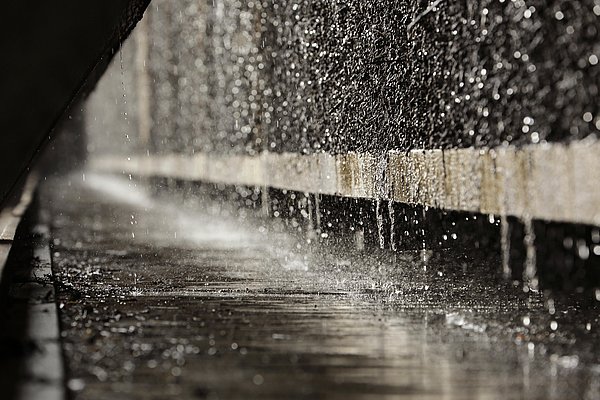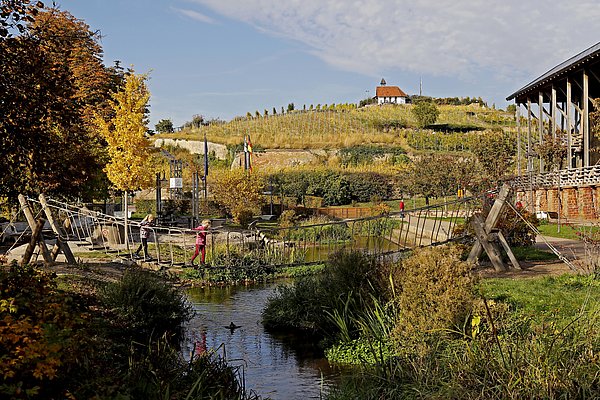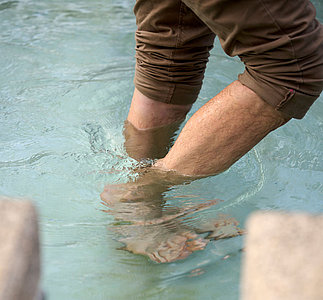

Original text: Cordula Schulze
You can enjoy peace and quiet in the Palatinate spas while experiencing the healing and restorative powers of water.
Bad Dürkheim on a sunny weekend in August 2022. Just as I arrive, I catch sight of the 333-metre-long Gradierbau saltworks and approach it with curiosity. A large crowd has gathered there. Some walk deliberately and slowly, deeply inhaling the salty air. You can see they are serious about what they are doing. Others, like me, enjoy the fresh breeze that forms when salty spring water rushes over brushwood bundles and swirls into a fine mist. Breathing in this air is said to be good for the lungs and bronchial tubes. But at the very least, you get the sensation of being by the sea and the urge to take a big breath. Of course, not everyone is here for their health.
Families on holiday can be heard speaking English, French and other foreign languages. There is the sound of happy children's voices. A brand-new water play area next to the Gradierbau is proving quite a hit. A few steps further into the spa park, the same scene: people of all ages are sharing the grassy area under the shade of the old ornamental cherry and plane trees. Grey-haired ladies, growing old gracefully, are just as relaxed strolling with their walkers as friends and families. The enormous fountain dances, rushes and splashes – an ideal place to take a seat on the nearest bench and let your thoughts wander.


"A lot of imagination and money has gone into the spa park since 2010," explains Gerrit Altes from the tourist information office, as background for the current building work. This includes the fact that the Isenach, which used to run underground, has been flowing through the spa park again since 2014 – a present to the local residents too who now have "their" stream back. Since 2015, the spa park has also been extended east of the Gradierbau, with the ancient listed Brunnenhalle being carefully renovated into an information, event and catering facility. The newly constructed thermal baths should be finished by the end of 2024.
Another piece of the jigsaw puzzle that is Bad Dürkheim's spa facilities has been added near the Gradierbau entrance: the new Kneipp water-treading pool with its two artful sculptures of the Celtic goddess of healing, Sirona, and the Roman woman, Lukulla. Artist Tanja Lebski's sculptures symbolise the Palatinate region's ideals of Lucullan pleasures. Guests and health-conscious individuals can enjoy invigorating baths for their arms and legs here. There is also a leg pool for wheelchair users. Susanne Hißler, chair of the local Kneipp association, is delighted with the new Kneipp facility. Even her grandparents were Kneipp followers.
As early as the mid-19th century, a farmer's son, Sebastian Kneipp, used cold river water to successfully treat a lung condition. This prompted him to look into water's curative properties more thoroughly. Soon, he began to think about preventive health maintenance in addition to healing. Kneipp therefore went on to add traditional herbal medicine and other foundations to his teachings. He spread his knowledge through lecture tours and multiple books – including in the Palatinate region.
In 2015, 'Kneippism' was included in the German UNESCO Commission's list of Intangible Cultural Heritage. Back to today: what can the clergyman with the health advice still teach us in today's fast-paced, digitalised world? Can we safely dismiss his findings as "old wives' tales", or are his insights still relevant in our modern world? "Definitely," according to Susanne Hißler. The osteopath has noticed a rise in coverage of Kneipp in the press. Many of the things he considered to be health-promoting are still so today. Examples? Eating modestly, regionally and seasonally is both healthy and cost-effective. Consciously taking time to eat and exercising moderately in endurance sports. Many Kneipp associations now offer yoga, which was not available back then. Yoga, for example, excels at combining movement and awareness. Those unfamiliar with herbs can take guided tours to learn more and even create their own mini herb garden. Healing herbs can be grown even on a windowsill!
Sebastian Kneipp's health teachings encompass five areas of life. Each one is meant to help maintain health and balance our life forces.
1 Water healing:
It has been demonstrated that cold and heat influences stimulate the skin, blood vessels, nerves, internal organs and immune system. Dip, pour and wrap!
2 Medicinal herbs:
According to Kneipp, plant extracts, whether used as a tea, bath supplement, tincture or seasoning, contribute to health in the spirit of ancient medicinal and healing plants. Learn all about them in the herb garden or on your windowsill.
3 Nutrition:
The beauty of Kneipp is that nothing is off limits, although stimulants should be treated as such. For nutrition, he advocates natural whole foods that are as low in fat and calories as possible and plenty of fruits and vegetables.
4 Exercise:
No need to rush – instead, discover your own pace and rhythm. Endurance sports such as walking, hiking or gymnastics prevent obesity and metabolic diseases.
5 Lifestyle:
What may appear to be a complex topic at first is one of the major issues of our time. The goal is to find a happy medium between stress and relaxation. Achieving a healthy work-life balance is the modern equivalent of what Kneipp called "inner contemplation and tranquillity".
I move on to the Bad Bergzabern Kneipp health spa with these useful tips in mind. The sun is shining, and I drive leisurely through the vineyards that make up this peaceful landscape. Like Bad Dürkheim, the town is surrounded by wooded hills and has a long history as a spa and health resort. The first spa facilities were created here around the end of the 19th century, and in 1894, the hydrotherapist Eduard Tischberger founded a cold-water sanatorium, the forerunner of the later Kneipp spa facilities. Sebastian Kneipp learned about the site and visited it during a lecture tour. He approved of what he saw. He was full of glowing praise for the facility: "If I hadn't started in Wörishofen, I would have had to do it here." To this day, water remains a defining feature of Bad Bergzabern and its health facilities. Kneipp therapy gained in popularity after World War II, following the development of therapeutic springs in the 1920s and 1930s. Spa-goers did not show much enthusiasm for the then-brand-new thermal baths until the 1970s.
Kneipp's great legacy lives on, thanks partly to Dr Wieland Hassinger's dedication. The spa doctor has had his practice in his home town for 40 years. He also serves as the chairman of the local Kneipp association and incorporates Kneipp therapies into his everyday work with patients. He believes Kneipp's teachings are highly relevant to today's health problems. Even though the priest was active during the early days of the Industrial Revolution, there are parallels, as Wieland Hassinger points out: "The water treatments are just one component of Kneipp's five-element teaching. Because of the stress in our lives, many of us don't exercise enough, eat badly, and don't take the time to reconnect with who we are, so a more holistic approach like this is exactly what we need." Kneipp finds solutions and advice for all of these societal health problems.


The key aspect here: "Kneipp does not forbid anything. Instead, he offers advice that everyone can put into practice, fully or at least in part. This improves people's state of mind," the internist says. He adds: In Bad Bergzabern, there has been a state-recognised Kneipp kindergarten since 2007, where children learn about living a healthy lifestyle from an early age.
The Erlenbach, a stream that has been renaturalised, is a new addition to the spa gardens. It adds to the green area created in the 1950s by providing another location for people to enjoy water in nature. Kneipp enthusiasts also get their money's worth here, as there is a 5.5-kilometre-long themed nature trail that winds past a newly created herb garden and the classic water treading pool, eventually leading up to the hills above the city. Exercise stations encourage an active lap before visitors return to the town to discover the more pleasurable aspects of the Palatinate region.
If you fancy a longer walk, there are plenty of places to go hiking and lots of water for a refreshing paddle in the Palatinate, especially in the area designated as a UNESCO biosphere reserve. Ponds and rivers meander across the landscape, creating a sprawling spa park. Forest air fills your lungs with freshness, urging you to take deep breaths. Here, in this natural setting, you can find serenity and concentrate on what matters most. "With the 'order of life' pillar (also known as 'relaxation'), Kneipp encourages us to take time to reconnect with our own soul," Wieland Hassinger explains. Where, if not here, is a good place for that?
"Don't neglect the soul!" advises Kneipp. We want to take this to heart and work on aligning our pace of life with our personal needs and preferences. The water-treading pool beside the Erlenbach in the spa gardens is the first stop on the path to a healthy lifestyle. How refreshing to step right into the cool water! A woman who has finished her laps for the day smiles contentedly and squints in the sun. I look for a place to sit and do the same.